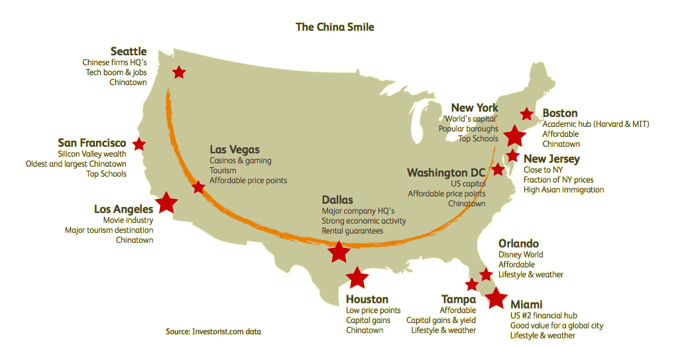The 5 US housing markets Chinese investors like most
Chinese buyers spend more money on US residential real estate than any other foreign investors, and now we have a better sense of where they’re putting their money.
By conducting in-depth interviews with 120 agencies throughout mainland China, real estate platform Investorist compiled a list of five US housing markets where Chinese buyers are projected to spend the most money in the next 12 months: Los Angeles, California; Miami, Florida; New York, New York; San Francisco, California and Boston, Massachusetts.
Chinese investors are drawn to these cities because of quality educational institutions and opportunities, according to the report. “Children’s education” was the top reason driving demand, just ahead of migration, according to the report.
Top US markets for Chinese homebuyers
The No. 1 housing market for Chinese investors boasts some of the best public universities in the US. Apart from the UC school system, Chinese investors are flocking to LA because of the bargain pricing by international standards, particularly compared to San Francisco.
With its idyllic weather, rising land values and an increasing amount of Chinese students at the prestigious University of Miami, Miami is a hub for Chinese investors. Miami suburb North Miami has unveiled new drawings of its planned Chinatown Cultural Arts and Innovation District, complete with large pagodas, lush green spaces, and vertical and rooftop gardens.
Meanwhile, New York City, the world’s No. 1 financial hub, provides academic excellence with its top-tier magnet high schools and universities. New York also carries the appeal of rising land values, as well as a spike in development in boroughs like Queens and Brooklyn.
San Francisco — which comes in as the No. 4 housing market for Chinese investors — has the oldest Chinatown in North America and the largest Chinese enclave outside Asia. Condominiums are particularly desirable, with the appeal of Silicon Valley’s tech hub, strong economic growth and soaring returns on investment.
Rounding out the top five is Boston. Known for its elite colleges and universities, Boston has a vibrant urban core and is experiencing the rise of luxury-branded condominiums. Boston also ranks as No. 3 in terms of the number of international students in US metro areas, trailing New York and Los Angeles.
Finding the “sweet spot” in American metro areas
The surveyed agents sold 10,540 overseas units to Chinese investors in 2016, an increase of 40% over the previous year’s sales.
The key international markets that Chinese are buying property in are similar to last year, with the US notably gaining popularity, according to the report.

When it comes to pricing, the US has a “sweet spot” range when it comes to optimally priced property for Chinese investors. If properties are priced too far below this range, investors assume that something is wrong with the property as it appears to be “too cheap.”
In popular US states, the range is $300,000 to $700,000.
“In the first 12 months of Investorist’s operations in US, we have experienced growing demand from China for US property, particularly the states of New York and Florida. With the US election over, Chinese investors have become even more bullish,” says Josh Cunningham, VP of Investorist’s Americas division.
Overall, sentiment from Chinese agents was very positive about buying opportunities for the next 12 months, according to the Investorist report. Among the agents, 70% predict an increase in sales volume over the next year.
“The smartest developers are investing in marketing their projects on the ground in China and committing the financial and personnel resources required,” Cunningham said, “as they can see the incredible opportunities in this market.”
Melody Hahm is a writer at Yahoo Finance, covering entrepreneurship, technology and real estate. Follow her on Twitter @melodyhahm.
Read more: